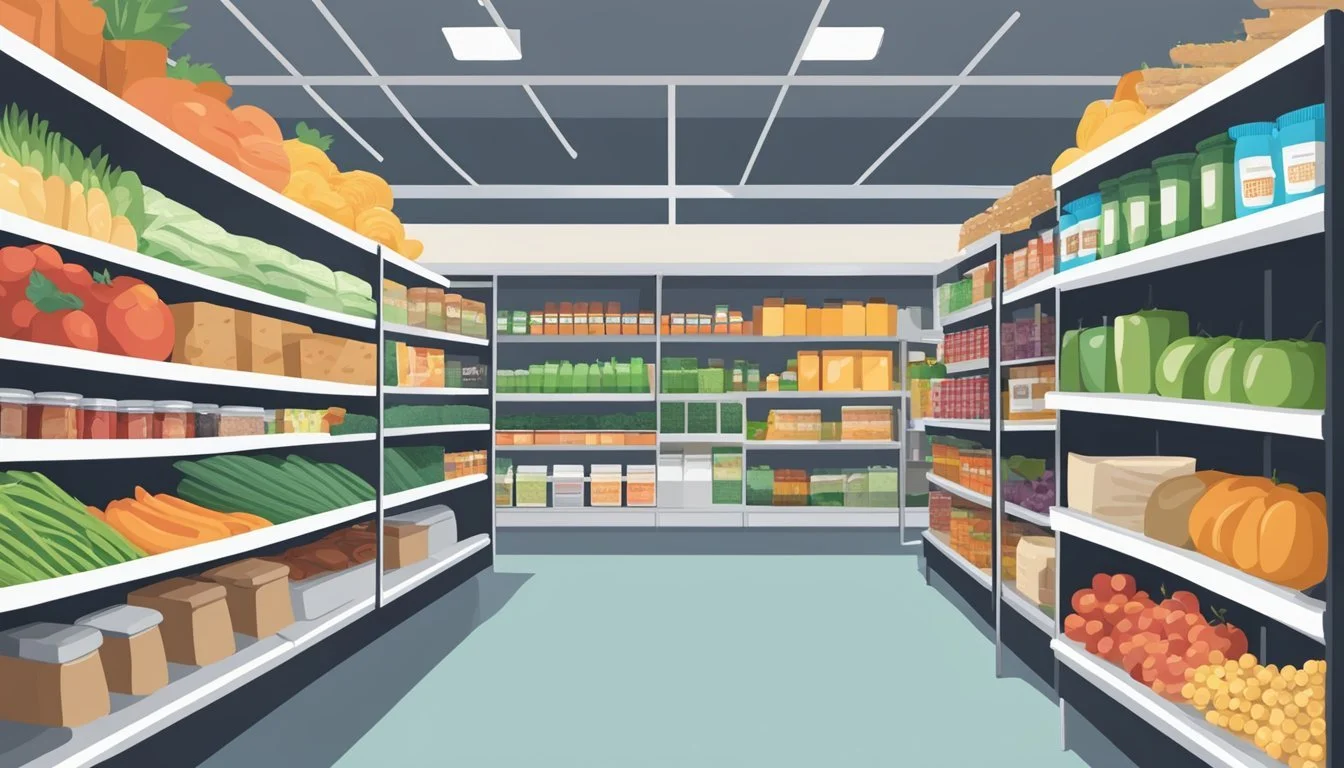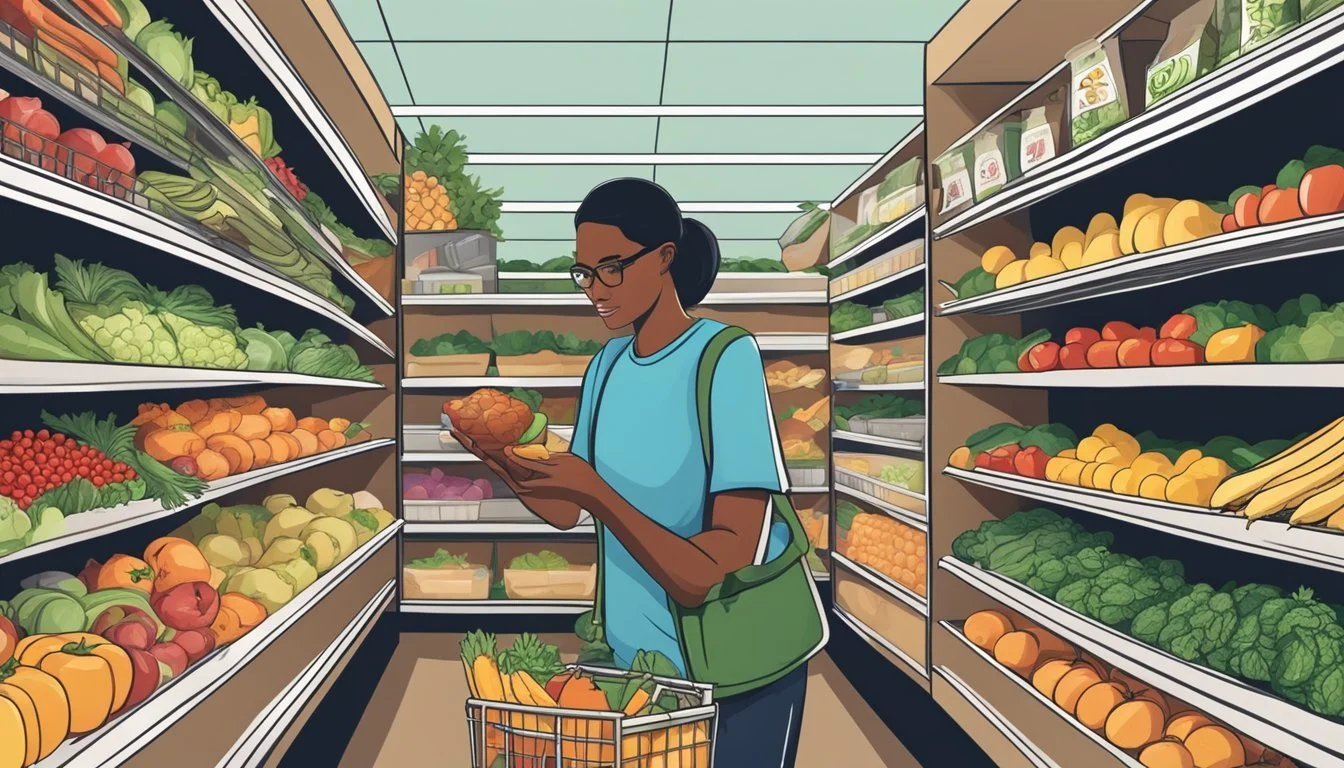Campus Cuisine on a Budget: Top Grocery Stores for Savvy College Shoppers
College students face unique challenges when it comes to grocery shopping. Balancing a tight budget with the need for nutritious meals can be tricky. Many find themselves searching for affordable options that still provide the sustenance needed for long study sessions and busy schedules.
Aldi stands out as an excellent choice for college students seeking budget-friendly groceries. This discount supermarket chain offers a wide range of essential items at competitive prices. Students can stock up on staples like pasta, rice, eggs, and fresh produce without breaking the bank. Aldi's store-brand products often match the quality of name-brand alternatives at a fraction of the cost.
Creating a smart college grocery list is key to maximizing savings. Focusing on versatile ingredients that can be used in multiple dishes helps stretch a limited food budget. Items like frozen vegetables, canned beans, and whole grains provide both nutrition and value. By shopping strategically at budget-friendly stores like Aldi, college students can maintain a healthy diet without sacrificing their financial well-being.
Why Focus on Grocery Shopping in College
Grocery shopping in college plays a crucial role in maintaining health, managing finances, and developing life skills. Students who master this essential task can improve their nutrition, save money, and learn valuable planning strategies.
Balancing Nutrition and Budget
College students face unique challenges when it comes to maintaining a balanced diet on a limited budget. Proper nutrition is essential for academic performance and overall well-being. By focusing on grocery shopping, students can select nutritious options at lower costs compared to eating out or relying on campus meal plans.
Fresh produce, lean proteins, and whole grains are often more affordable when purchased from grocery stores. Students can opt for seasonal fruits and vegetables to maximize nutritional value while minimizing expenses. Buying in bulk and choosing store-brand items can further reduce costs without sacrificing quality.
The Value of Meal Planning
Meal planning is a valuable skill that college students can develop through regular grocery shopping. This practice helps students manage their time and resources effectively. By planning meals in advance, students can create shopping lists, reduce food waste, and avoid impulsive purchases.
A well-structured meal plan ensures a varied and balanced diet throughout the week. Students can prepare larger batches of meals and store leftovers, saving both time and money. This approach also minimizes the temptation to order takeout or rely on unhealthy convenience foods during busy periods.
Strategies for Saving Time and Money
Effective grocery shopping strategies can significantly impact a student's budget and schedule. Comparing prices between different stores, using coupons, and taking advantage of student discounts can lead to substantial savings. Many grocery stores offer loyalty programs that provide additional benefits to regular shoppers.
Shopping during off-peak hours can help students avoid crowds and make more thoughtful purchasing decisions. Utilizing grocery delivery or pickup services can save time for those with busy schedules. Students can also collaborate with roommates to buy in bulk and split costs, further reducing expenses and fostering a sense of community.
Essential Grocery Shopping Tips for College Students
Smart grocery shopping can help college students eat well on a budget. Creating a thoughtful list, understanding nutrition labels, and finding deals are key skills to develop.
Creating a Smart and Healthy Grocery List
Start by planning meals for the week. Include versatile ingredients that can be used in multiple dishes. Focus on affordable, nutrient-dense foods like:
Fruits: apples, bananas, frozen berries
Vegetables: carrots, spinach, broccoli
Proteins: eggs, canned tuna, beans
Grains: brown rice, whole wheat pasta, oats
Keep staples like olive oil, spices, and condiments on the list. Add snacks in moderation, such as nuts or popcorn. Review the list before shopping to avoid impulse buys.
Understanding Food Labels and Nutrition
Learn to read nutrition labels for informed choices. Compare similar products to find healthier options. Key things to check:
Serving size
Calories per serving
Protein, fiber, and vitamin content
Added sugars and sodium
Look for whole grains as the first ingredient in bread and cereals. Choose lean meats and low-fat dairy when possible. Avoid foods with long lists of artificial ingredients.
Finding the Best Deals
Compare prices between stores and brands. Many grocery stores offer student discounts - ask at customer service. Other money-saving strategies include:
Buy generic or store brands
Use store loyalty cards
Clip coupons or use coupon apps
Shop sales, especially for non-perishables
Buy produce in season
Consider splitting bulk purchases with roommates. Frozen vegetables and fruits are often cheaper and last longer. Be wary of deals on junk food - focus on nutritious options to stretch the grocery budget.
Must-Have Staples for the College Pantry
Stocking a college pantry with nutritious, versatile, and budget-friendly foods is essential for student success. Smart choices can fuel long study sessions and provide quick meals between classes.
Protein-Packed Foods for Energy
Peanut butter is a college staple, offering protein and healthy fats. It's perfect on toast or with apple slices for a quick snack. Canned tuna and beans are affordable protein sources that require no refrigeration. Greek yogurt provides protein and probiotics, doubling as a breakfast or snack option.
Hummus serves as a nutritious dip for veggies or spread for sandwiches. Eggs are versatile and can be prepared in multiple ways. For busy mornings, protein bars or shakes offer on-the-go nutrition.
Protein-rich staples:
Peanut butter
Canned tuna
Beans (black, kidney, chickpeas)
Greek yogurt
Hummus
Eggs
Protein bars/shakes
Long-Lasting Fruits and Vegetables
Apples are an excellent choice for dorm life, as they stay fresh for weeks. Bananas offer quick energy and pair well with peanut butter or oatmeal. Carrots and celery sticks provide crunchy, nutrient-dense snack options.
Frozen vegetables retain their nutrients and can be easily added to various dishes. Canned tomatoes and corn are versatile ingredients for quick meals. Onions and garlic add flavor to dishes and have a long shelf life.
Long-lasting produce:
Apples
Bananas
Carrots
Celery
Frozen mixed vegetables
Canned tomatoes
Onions
Garlic
Grains and Carbs for Sustenance
Oatmeal is a filling breakfast option that can be customized with various toppings. Brown rice serves as a base for many meals and offers more nutrients than white rice. Whole grain bread provides fiber and can be used for sandwiches or toast.
Pasta is quick to prepare and can be paired with various sauces. Quinoa offers complete protein and cooks faster than rice. Cereal is a convenient breakfast or snack option when paired with milk or yogurt.
Essential grains and carbs:
Oatmeal
Brown rice
Whole grain bread
Pasta
Quinoa
Cereal
These staples form a solid foundation for a college pantry, providing balanced nutrition and meal flexibility.
Navigating Grocery Stores and Markets
Selecting the right grocery store and planning efficient shopping trips are essential skills for college students. These strategies help save time and money while ensuring a well-stocked kitchen.
Choosing the Right Grocery Store or Market
College students should prioritize stores that offer competitive prices and a good selection of essentials. Discount chains like Aldi, Lidl, and Trader Joe's often provide quality products at lower costs. Local farmers' markets can be great for fresh produce.
Stores near campus may be convenient but can have higher prices. Students should compare options within walking distance or along public transit routes. Some stores offer student discounts, so it's worth asking about special promotions.
Online grocery delivery services are another option to consider. While they may have fees, they can save time and reduce impulse purchases.
Efficiently Organizing Your Shopping Trip
Creating a detailed shopping list is crucial for staying on budget and avoiding unnecessary items. Students should plan meals for the week and check their kitchens before heading out.
Grouping items on the list by store section (produce, dairy, etc.) can streamline the shopping process. It's helpful to familiarize oneself with the store layout to navigate quickly.
Shopping during off-peak hours, such as weekday mornings, can reduce time spent in lines. Buying in bulk for non-perishable items or splitting large quantities with roommates can lead to savings.
Using store apps or loyalty programs can provide additional discounts and help track spending. Students should also compare unit prices to ensure they're getting the best value.
Meal Preparation and Cooking Basics
Effective meal preparation and cooking skills are essential for college students. These techniques help save time, money, and ensure proper nutrition while juggling a busy academic schedule.
Simple and Quick Meal Ideas
Peanut butter toast with banana slices makes a quick and satisfying breakfast. For lunch, try a Greek yogurt parfait with granola and berries. Dinner can be as simple as a microwave-friendly burrito bowl with rice, beans, and pre-cooked chicken.
Instant oatmeal is versatile for any time of day. Add nuts, honey, or fruit for extra flavor and nutrition. Protein bars or shakes are convenient grab-and-go options for rushed mornings.
Meal prepping is a time-saving strategy. Students can prepare a large batch of food on weekends to portion out for the week ahead. This method works well for dishes like stir-fries, pasta salads, or roasted vegetables.
Utilizing Dorm Room Cooking Appliances
A microwave is often the primary cooking tool in dorm rooms. It can be used to make oatmeal, heat soup, or cook vegetables. Microwaveable mug recipes are popular for quick single-serving meals.
If allowed, small appliances like electric kettles or mini-fridges expand cooking possibilities. Kettles are great for instant noodles, tea, or coffee. Mini-fridges keep perishables fresh and store leftovers.
Some dorms may permit slow cookers or rice cookers. These devices can prepare meals while students attend classes, providing hot food upon return. They're excellent for soups, stews, or one-pot meals.
How to Store and Keep Food Fresh
Proper food storage is crucial to prevent waste and maintain freshness. Airtight containers help keep dry goods like cereal or pasta from going stale. They also protect against pests.
Fresh fruits and vegetables last longer when stored correctly. Most produce should be refrigerated, except for items like bananas, potatoes, and onions. These are best kept in a cool, dry place.
Leftovers should be refrigerated promptly and consumed within a few days. Label containers with dates to track freshness. For longer storage, consider investing in reusable freezer bags to store pre-portioned meals.
Budgeting for Groceries
Managing grocery expenses is crucial for college students to maintain a balanced budget. By setting realistic spending limits and avoiding unnecessary purchases, students can make their money go further.
Setting Up a Monthly Grocery Budget
The average college student spends between $180 and $320 per month on groceries. This translates to approximately $65 per week. To create an effective budget, start by tracking food expenses for a month. Analyze receipts and categorize purchases.
Consider allocating about 10-15% of your total budget to groceries. If rent takes up a significant portion of income, adjust accordingly. Aim for a grocery budget that allows for nutritious meals without straining finances.
Use apps or spreadsheets to monitor spending. Set weekly limits and stick to them. Plan meals in advance to avoid impulse buys. Buy in bulk for non-perishable items to save money over time.
Avoiding Unnecessary Purchases
Impulse buying can quickly derail a grocery budget. Make a shopping list before heading to the store and stick to it. Avoid shopping when hungry, as this often leads to unplanned purchases.
Compare prices between stores and look for student discounts. Choose generic or store-brand products over name brands. These often have similar quality at a lower cost.
Skip pre-packaged or processed foods. Whole ingredients are typically cheaper and healthier. Limit purchases of snacks, sodas, and other non-essential items.
Utilize coupons and loyalty programs. Many stores offer digital coupons through their apps. Take advantage of sales, but only for items you actually need.
Healthy Eating on the Go
College students can maintain a nutritious diet even with busy schedules. Quick, portable options and smart hydration choices make it easy to fuel up between classes or activities.
Packable Snacks and Lunches
Pre-portioned trail mix combines nuts, dried fruits, and whole grains for a balanced snack. Granola bars offer convenience and nutrients in a compact form. Fresh fruit like apples, bananas, or oranges travel well and provide natural sweetness.
Whole grain wraps filled with lean proteins and vegetables make satisfying lunches. Hard-boiled eggs, Greek yogurt cups, and veggie sticks with hummus are protein-rich choices. Overnight oats in a jar offer a filling breakfast or snack.
For longer days, insulated lunch bags keep perishables fresh. Batch-prepped meals in divided containers save time and ensure balanced nutrition throughout the week.
Beverages and Hydration
Water is essential for staying hydrated. Reusable water bottles encourage regular sipping throughout the day. Infusing water with fresh fruits or herbs adds flavor without extra calories.
Unsweetened tea provides antioxidants and gentle caffeine. Low-fat milk or plant-based alternatives offer calcium and protein. 100% fruit juices in small portions can be occasional treats.
Electrolyte drinks may be beneficial after intense exercise. Coffee in moderation can boost energy, but students should be mindful of added sugars and creamers.
Accommodating Special Diets
Many grocery stores now offer extensive options for students with dietary restrictions or preferences. These selections cater to vegetarians, vegans, gluten-free eaters, and those with food allergies, making it easier to maintain a balanced diet while adhering to specific nutritional needs.
Options for Vegetarians and Vegans
Plant-based diets are well-supported by most modern grocery stores. The produce section is a cornerstone, offering a wide variety of fresh fruits and vegetables. Many stores now feature dedicated vegan sections with meat alternatives like tofu, tempeh, and seitan.
Dairy-free milk options such as almond, soy, and oat milk are readily available. Vegan cheese, yogurt, and ice cream alternatives have also become common. Beans, lentils, and chickpeas provide affordable protein sources for vegetarians and vegans.
Some stores offer pre-made vegan meals and snacks, saving time for busy students. Nutritional yeast, a popular vegan supplement, can often be found in the health food aisle.
Gluten-Free and Allergy-Friendly Choices
Gluten-free products have expanded beyond specialty stores and are now prevalent in most grocery chains. Dedicated gluten-free sections often include bread, pasta, crackers, and baking mixes.
Many stores label their products clearly for common allergens like nuts, dairy, and soy. This makes it easier for students with food allergies to shop safely.
Gluten-free grains such as quinoa, rice, and millet are typically available in the bulk foods section. Specialty flours like almond or coconut flour cater to those avoiding wheat.
For dairy allergies, stores now stock numerous milk alternatives and dairy-free versions of common products. Nut-free options are also more prevalent, with sunflower seed butter as a popular alternative to peanut butter.
Making the Most of Leftovers
Leftovers can be a college student's secret weapon for saving time and money. With some simple strategies, you can stretch your food budget and reduce waste.
Storing and Reusing Meals
Proper storage is key to keeping leftovers safe and tasty. Use airtight containers to store cooked meals in the fridge for 3-4 days. Label containers with the date to track freshness.
Transform leftover rice into fried rice by adding vegetables and eggs. Repurpose extra pasta into a cold pasta salad with dressing and chopped veggies.
Leftover meats can be sliced for sandwiches or diced for salads. Use remaining vegetables in soups, stir-fries, or omelets.
Freeze portions of casseroles or soups in individual containers for quick future meals. Thaw overnight in the fridge before reheating thoroughly.
Get creative with leftovers to avoid boredom. Add new spices or sauces to change up flavors. Combine ingredients from different meals to create entirely new dishes.
Useful Resources for College Grocery Shoppers
College students can benefit from various online and mobile tools to optimize their grocery shopping experience. These resources provide valuable information, budget-friendly recipes, and practical tips for efficient meal planning and shopping.
Online Blogs and Recipe Sites
Several websites cater specifically to college students' grocery needs. Budget Bytes offers affordable recipes with cost breakdowns per serving. The Kitchn provides practical cooking tips and simple recipes ideal for dorm kitchens. Tasty, known for its quick recipe videos, features a section dedicated to easy meals for students. These sites often include grocery lists tailored to specific recipes, helping students shop efficiently.
Many food bloggers create content aimed at college students, sharing tips on bulk cooking and meal prepping. Some blogs also offer printable grocery lists and meal planning templates. Students can find affiliate links to kitchen essentials and affordable ingredients through these platforms, potentially saving money on their purchases.
Mobile Apps for Budgeting and Shopping
Smartphone apps can streamline the grocery shopping process for college students. Flipp compiles local store flyers, allowing users to compare prices and find the best deals. Ibotta offers cash back on grocery purchases, helping students save money over time. Mealime provides personalized meal plans and generates grocery lists based on chosen recipes.
For budgeting, Mint helps track overall expenses, including groceries. BigOven allows users to input ingredients they already have and suggests recipes to reduce food waste. These apps often sync across devices, making it easy for students to access their lists and budgets on the go.








